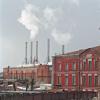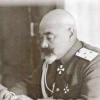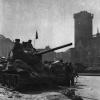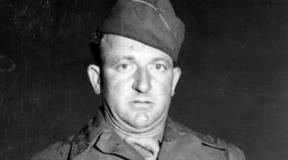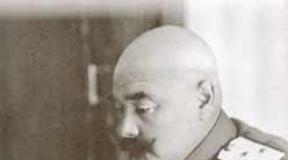What are the technical achievements of the Soviet Union. Technical achievements of the ussr

Russian mass media of a democratic orientation keep repeating around the clock that the Russian people are backward, second-rate, inferior, incapable of anything serious in science and technology, and the task of Russia now is only to wander in the tail of world civilization and try not too much far behind the developed capitalist countries.
And our young people believe them, because they have not the slightest idea about the life of an ordinary person in the Soviet Union, about the technical, scientific and social achievements of the Soviet government and Soviet society. They really believe that the Soviet T-34 medium tank is an American tank that we have converted, we borrowed the Kalashnikov assault rifle from the Germans, and we stole the atomic bomb from the Americans, and our space rockets are copied German developments of their latest models, the FAU-3 and FAU-4, captured by us in one of their missile center in the Baltic.
I constantly have to communicate with modern Russian youth. And I am amazed at her absolute “ignorance” of the history of her country of the twentieth century. Therefore, I once gave them a lecture on the Soviet contribution to world civilization.
The students were shocked. They did not know that Soviet civilization had such tremendous achievements in the technical and social development of the world. Although I told them only what has been preserved in my memory since Soviet times, when I worked as a freelance expert at the All-Union Scientific Research Institute of State Patent Examination or VNIIPGE for over fifteen years and made an examination of applications for inventions. And for this I had to be aware of the latest technical developments in the world. I present an excerpt from this lecture to your judgment.

TECHNICAL ACHIEVEMENTS OF THE SOVIET NATION OF WORLD IMPORTANCE
1.Tank T-34. This tank is recognized by the entire world community as the best medium tank of the Second World War. And nobody succeeds in hushing up this outstanding achievement of the Soviet military-industrial complex.
2. Tank KV. Even the Germans themselves recognized it as the best heavy tank of the first half of the Second World War and which the Germans could not knock out from any of their anti-tank guns. They equalized their chances in heavy tanks only with the release of their heavy tanks of the Tiger and Panther series.
3. Tank IS-2. The best heavy tank of the end of the Second World War, which even the fascist "Tigers" of all modifications could not compete with. Reluctantly, this fact is recognized by the majority of foreign experts.
4. Fighter Yak-3. The best light fighter of the Second World War, according to many foreign experts. In terms of its tactical and technical qualities, it surpassed any fighters of that time.
5. The Soviet atomic bomb, which we made in just two years from an almost empty place. You can say a lot about the fact that we, they say, took the atomic bomb project from the Americans. Speak if you have nothing else to do. Paper with drawings is one thing, but a finished object in the form of a nuclear charge is completely different.
Now the drawings of the atomic charge can be taken on the Internet. Take it and do it! Who's stopping you ?! However, nothing will come of it. Because for its manufacture it is necessary to create an appropriate scientific, technical and production base. And this base had to be created in a war-torn country. And the Soviet people, under the leadership of the Soviet government and their own Communist Party, have created such a base. Only for some reason there is no monument to this unprecedented feat of the Soviet people.
6. The hydrogen bomb, which we made the first in the world, ahead of the Americans themselves, who began working on it much earlier and worked for almost ten years. And we got it in 1949 on a war-ravaged land. What was the most powerful potential that the Soviet civilization possessed, if it turned out to be capable of such an impossible ?!
7. The world's first nuclear power plant in Obninsk. As an example of the peaceful use of the atom. The Americans made atomic bombs and atomic submarines, but we took it, and with the help of the atom, we launched a power plant for ourselves, ahead of the rich, fat and never fought on its territory America.
8. The world's first nuclear icebreaker. Another example of the peaceful Soviet approach to the use of nuclear energy on the ground.
9. The world's first satellite of the earth. It was a terrible blow to the prestige and psychology of Americans. And they considered this Soviet success to be an accident.
10. But then followed the world's first launch of living beings of the highest class into Space, the dogs Belka and Strelka and their return to earth.
11. And then something happened that the Americans still cannot forgive us. The world's first cosmonaut, a citizen of the Soviet Union, Yuri Gagarin, appeared. It was then that the President of the United States uttered his famous words: the Russians defeated us in the competition for Space at the school desk. And it is this, the best education in the world, that the current Russian radical democrats have been actively destroying for two decades.
12. And then came our impressive achievements in space exploration: the world's first images of the far side of the moon, delivered to earth, and the world's first moon globe with detailed lunar relief.
13. The first pennant from the earth, delivered to the moon and left there forever, as a symbol of the triumph of the Soviet Socialist system on this earth.
14. The world's first moving vehicle, the so-called lunar rover, delivered to the moon and moving for many months on the surface of the moon and transmitting images of the moon to the earth.
15. The world's first orbital space station, orbiting the earth, with replacement crews of astronauts working on it for several months.
16. The world's first reusable spacecraft called "Buran", launched from an orbital vehicle and returning to earth in an automatic mode. An outstanding Soviet space achievement, later thrown into a landfill by the instructions of the US STATE DEPARTMENT by the new masters of Russia.
17. The world's first super-high, so-called Ostankino TV tower, built according to the most unusual and extremely safe domestic project.
18. The world's best rifle machine, a brilliant Soviet worker who became an Outstanding Soviet Designer, Mikhail Kalashnikov. In today's Russia, a man like him would never have been able to get a job except a loader in the market.
19. The world's most massive semiautomatic gas-shielded welding of metal structures with a consumable electrode and now called Russian welding or carbon dioxide welding.
20. Automatic submerged-arc welding of metals, with the help of which we welded the hulls of tanks in the "Tankograd" in the Urals in the Second World War.
21. Automatic welding of metal of unlimited thickness, the so-called electroslag welding, which in Soviet times was widely used in the manufacture of large body parts for various purposes weighing up to several thousand tons.
22. One of the most widespread methods of obtaining high-alloy steels with desired properties, now called electroslag remelting.
23. Mastering the serial production of multilayer coiled pipes for high-pressure gas pipelines, butt welding of which during installation in the field is now carried out according to the method proposed by the author of this article.
24. Mastering the production of brazed instead of welded metal masts of high-voltage transmissions.
25. Mastering the production of the world's largest converters for steel smelting with a capacity of over five hundred tons.
26. Mastering the production of converter steel with blowing the liquid melt with oxygen instead of air.
27. Introduction in the country of a unified energy system, the only one in the world for such large-area states. In America it is still not there, but we have it! More precisely - it was! Mr. Chubais, together with his friend Yeltsin, destroyed it.
28. A single geological map for the whole country, according to which it is still possible to predict the location of various minerals. There is still no such map in any major country in the world.
29. The world's first installation for controlled thermonuclear fusion of the TOKAMAK type
30. The world's first mobile installation for launching ballistic missiles based on railway cars, which has no analogues in the world and which we destroyed at the request of the US STATE DEPARTMENT in the memorable nineties.
31. The world's first nuclear submarine with a double-layer welded hull, capable of operating at depths of over six hundred meters.
31. The world's first nuclear-powered submarine with a welded titanium hull, capable of submerging to a depth of thousands of meters.
34. The world's first aircraft with variable wing geometry, which made a splash at the Le Bourget Aviation Parade.
35. The world's first vertical lift and landing aircraft.
36. The world's first jet passenger liner.
37. The world's first supersonic passenger liner.
38. In general, it must be admitted that more than forty percent of the world's passenger aviation in the second half of the twentieth century was equipped with Soviet aircraft.
39. The world's first "ekranoplan", a kind of flying hybrid of a sea ship and an airplane, which was tested in the late eighties and has no analogues in the world.
40. The world's first giant transport aircraft capable of carrying over 250 tons of payload by air.
41. The world's first hydrofoil ship.
42. The world's first resistance butt welding of large-size hulls of diesel engines of diesel locomotives and sea vessels.
43. The world's first industrial resistance butt welding of pipes of main pipelines in the field.
44. The first and only carousel in the world for processing hydraulic turbine casings with a faceplate diameter of fifteen meters.
46. The world's first heavy-duty dump truck with a lifting capacity of 850 tons for coal and iron ore deposits in southern Yakutia.
47. The only country in the world to produce large-capacity walking excavators with a bucket capacity of over 150 cubic meters.
48. The only country in the world that produces high-capacity floating dredges for the extraction of gold and rare earth minerals from the bottom of rivers.
Everything that I have named here is just what came to my mind at once and what can be said immediately, offhand, and which was known to almost every technically competent and technically inquisitive Soviet person. These achievements of ours were widely reported in the magazines Tekhnika Molodoi, Znaniya i Sila, Nauka i Zhizn, Yuny Tekhnik, and in a number of other periodicals of the Soviet Union with millions of copies. And which we do not have in the country now. They were replaced by countless glossy magazines with half-naked and completely naked girls.
And I probably missed something and for which I apologize to my readers. But if anyone has additions to this list of mine, I would gladly accept them!
Hence an elementary conclusion suggests itself, from which you can not get away, even if you wanted to. The conclusion is as follows: the Soviet Union in its development was at the forefront of world technical progress and its contribution to the development of human civilization is extremely great. That is, the Soviet state system turned out to be an order of magnitude more effective than the capitalist one. Despite its natural costs and three terrible wars that swept across our vastness.
Under the Soviet system, under Soviet rule, Russia developed rapidly. Moreover, it developed not due to foreign investments that came to us for free for crazy profits, but due to its internal reserves and the immense resources of the Soviet state system based on Socialist Democracy.

And nothing new can be produced, since the dismantling of the entire scientific and industrial base has been successfully carried out.



The USSR - a large and strong state, located on 1/6 of the land - was a real factory of achievements. In any industry, be it science, defense, culture or sports, the Soviet Union had someone and something to be proud of! The main achievement of the Soviet era in the 1920s was the electrification of the entire country, the elimination of illiteracy, and overcoming the consequences of the revolution and the Civil War. Education and medical care became free for all Soviet citizens. The 1930s marked the beginning of the time of grandiose construction projects: units were commissioned at the Dneproges, the White Sea-Baltic Canal was built. The 1940s were marked by the victory over fascism and the beginning of the country's reconstruction. Among the achievements of the 1950s are the successful testing of the hydrogen bomb, the launching of the atomic icebreaker "Lenin", the development of virgin lands in Kazakhstan, the Volga region, the Urals, Siberia, and the Far East. The "Space Decade" of the 1960s showed that the USSR was the first in the world of space technology, which began with the flight of Yuri Gagarin into space. 1970s and 1980s - the triumph of Soviet culture: the glory of Russian ballet and hockey is thundering all over the world, the Olympics are being held in Moscow. The USSR really went ahead of the entire planet! We have no right to be ashamed of our recent past, because we have something to be proud of, - says this book about the greatest achievements of the Soviet era.
From the series: Russian history
* * *
company liters.
Achievements of the USSR on the scale of five-year plans
The great Soviet past must be known and must be constantly reminded of, first of all, as a token of gratitude to our ancestors for their heroic labor and military exploits, and also so that our children and grandchildren could find that patriotic foundation on which to build a bright future.
For the convenience of perceiving the material, we will present the achievements over the five-year periods - the periods of time adopted for planned management in the USSR. Here are the brief results of the five-year plans in order to trace the dynamics of success, the dynamics of creation under the social system that bore the name socialism.
On December 3, 1927, JV Stalin said: "Our plans are not plans-forecasts, not plans-guesses, but plans-directives, which are binding on the governing bodies and which determine the direction of our economic development in the future on a national scale." Almost a year later, on November 19, 1928, the leader once again set the task: “It is necessary to catch up and overtake the developed capitalist countries. Either we will achieve it, or they will overwhelm us. " Since 1928, the USSR State Planning Committee began to draw up five-year plans and monitor their implementation.
Five-year plans for the development of the national economy of the USSR, or five-year plans were intended for the rapid economic development of the Soviet Union. The plans were developed centrally on a nationwide scale by a specially created state body (Gosplan of the USSR) under the leadership of the Communist Party of the Soviet Union. The fulfillment of the plan became an incentive for the Soviet working people (Stakhanov movement, socialist competition, etc.).
The same planning method was adopted by most of the other socialist states, as well as by the government of India. In addition, several capitalist states have imitated the concept of central planning, albeit in the context of a market economy, setting joint economic goals for a finite period of time. This is how the Seven Year Plans and the Twelve Year Plans came about.
Several five-year plans did not take up their full timeframe (some were successfully completed ahead of schedule, while others failed and remained unfulfilled). The first five-year plans were formed with the goal of rapidly industrializing the Soviet Union, and therefore focused on heavy industry. There were 13 five-year plans in total. The first was adopted in 1928, for a five-year period from 1929 to 1933, and was completed a year earlier.
In 1959, at the XXI Congress of the CPSU, a seven-year plan for the development of the national economy for 1959-1965 was adopted. In the future, five-year plans were again adopted.
The last, thirteenth Five-Year Plan was designed for the period from 1991 to 1995 and was not implemented due to the collapse of the Soviet Union in 1991 and the subsequent transition to a decentralized market economy.
The first five-year plan (1929-1932)
In fact, the first five-year plan was completed at an accelerated pace: in four years. The volume of gross industrial output over these four years has doubled, including: electricity, sulfuric acid - 2.7 times, coal and oil - 1.8 times, steel - 1.4 times, cement - 2 times, metal-cutting machines - 10 times, tractors, cars - 30 times.
From JV Stalin's speech on February 4, 1931: “We are 50-100 years behind the advanced countries. We have to cover this distance in 10 years. Either we do it, or they will crush us. "
In Ivanovo built, equipped and launched: the largest in Europe Melange Combine; spinning factories - Krasnaya Talka and them. Dzerzhinsky, plant of peat machines; in Nizhny Novgorod - automobile factories, in Kharkov and Stalingrad - tractor factories; Uralmash ... Trains went along Turksib to Central Asia. By the end of 1930, there was no unemployment in the country. With the beginning of collectivization, technology came to the village. There are practically no illiterates left in the country.
From JV Stalin's speech: "We have done more than we ourselves expected: the tractor, automobile, aviation industries, machine-tool building, agricultural machine-building have been re-created, a new coal and metallurgical base has been re-created in the East."
The same five-year plan through the eyes of journalist S. Shevchenko:
1st FIVE YEARS (1928-1932)
"In accordance with the policy of industrialization of the country, first of all, the production of means of production should be strengthened ... the growth of heavy and light industry, transport and agriculture ... The fastest pace of development should be given to those industries that raise the economic power and defense capability of the USSR in the shortest possible time."
The intensive industrialization of the country began.
In total, 1,500 large industrial enterprises were built.
The national income has almost doubled.
The volume of industrial production has more than doubled.
Construction of the Dneproges power plant (the largest in the world).
Metallurgical plants were built in the cities of Magnitogorsk, Lipetsk, Chelyabinsk, Novokuznetsk, Norilsk, Sverdlovsk (Uralmash).
Tractor plants were built in the cities of Stalingrad, Chelyabinsk, Kharkov, Nizhniy Tagil (Uralvagonzavod).
Automobile factories were built: GAZ, ZIS.
New industries have appeared: tractor, automobile, aviation, machine-tool, heavy and agricultural engineering, ferrous metallurgy, and chemical.
The second coal and metallurgical base was created - Kuzbass.
The Turkestan-Siberian railway was put into operation.
Unemployment was eliminated in the country and a 7-hour working day was introduced.
Socialist reforms in agriculture: 211,000 collective farms, 150,000 tractors, 2,446 machine-tractor stations, 70,000 specialists with higher and secondary education.
The gross industrial output exceeded the 1913 level by 3 times.
The USSR came in second in the world in mechanical engineering, iron smelting and oil production, and in third in electricity production.
"The foundation of the socialist economy has been built, the victory of socialism in the USSR is assured."
The second five-year plan (1933-1937)
Over the five-year period, the national income has grown 2.1 times, industrial products - 2.1 times, agriculture - 1.3 times. The Ural-Kuzbass, the country's second coal and metallurgical base, was built. In 1935, metro lines were put into operation in Moscow. The Stakhanov movement "For shock labor" was widely developed in the country. In 1937, the Dnieper Hydroelectric Power Station gave the first current, the construction of the Moscow-Volga navigable canal was completed, Papanin's expedition landed at the North Pole and deployed the first polar station SP-1, the crew of the ANT-25 aircraft V. Chkalov, G. Baidukov, A. Belyakov made a non-stop flight from the USSR to the USA through the North Pole. By the end of the five-year plan, 97 out of every hundred peasant households were on collective farms.
2nd FIVE YEARS (1933-1937)
The head of state is I. V. Stalin.
A total of 4,500 large industrial facilities have been built.
The national income has grown 2.1 times.
The volume of industrial production increased 2.2 times.
The volume of agricultural products increased 1.3 times.
Highly qualified personnel have been trained. Slogan: "Cadres decide everything!"
Military factories were built, and they began to produce tanks, aircraft, guns.
Metro construction in Moscow.
Intensive development of domestic aviation - new institutes, design bureaus, factories.
On the ANT-25 aircraft, the crew consisting of V. Chkalov, G. Baidukov, A. Belyakov made a non-stop flight across the North Pole from the USSR to the USA.
Canals have been built - Belomoro-Baltic (227 km) and Moscow-Volga (128 km).
Schools have been built and opened - 3.6 thousand in cities and towns and 15 thousand in rural areas.
On the fields of collective and state farms already worked - 456 thousand tractors, 128 thousand combines, 146 thousand cars.
The result of the two Stalinist five-year plans - the USSR became a major industrial power, society consisted of friendly social strata (workers, peasants, intelligentsia), society was united, the friendship of peoples strengthened.
Third five-year plan (1938-1942)
In the first three years of the third five-year plan, industrial production increased by 45 percent, and machine building by 70 percent. In the face of the aggressive policy of Nazi Germany, special attention was paid to strengthening the country's defense capability, mastering and mass production of new types of military equipment and weapons. By 1939, the USSR had more universities and students than all European countries combined. The five-year plan was interrupted by the treacherous Nazi attack on June 22, 1941. At the beginning of the war, 1,310 large industrial enterprises, one and a half million carriages of cargo, and 10 million people were evacuated to the east.
3rd FIVE YEARS (1938-1942)
The head of state is I. V. Stalin.
Launched 3,000 new large industrial enterprises (up to June 1941)
The gross output of the entire industry increased by 45%, and that of machine building - by more than 70%.
The Uglich and Komsomolskaya hydroelectric power plants were commissioned.
Metallurgical plants were built - Novotagilskiy and Petrovsk-Zabaikalskiy.
Copper smelters were built - Sredneuralsky and Balkhash.
The Ufa oil refinery was built.
In 1940, the number of workers and employees rose to 31.2 million, compared with 11.4 million in 1928.
The five-year plan passed in the years of waiting for the war, so the expenditures on the army had to constantly increase - 25% (1939), 34% (1940), 43.4% (1941).
The production of new types of military equipment was mastered - medium tanks T-34 and heavy tanks KV, rocket launchers BM-13 ("Katyusha"), Il-2 attack aircraft ("Flying Tank"), Pe-2 bombers, LaGG-3 and Yak fighters. -one.
It was not possible to finish the five-year plan, the war began.
Great Patriotic War (1941-1945)
By the beginning of the war, the Red Army in the border districts had about 2.7 million people, 1475 new heavy and middle tanks (there were about 12 thousand in total), 1540 aircraft of new designs (there were about 10 thousand in total). The complete rearmament of the army took another 1-2 years.
After the outbreak of the war, about 2,000 enterprises and 11 million people were evacuated to the east of the country, where about 20% of the military factories were already operating, and there, on pre-prepared sites, the work of these enterprises was quickly organized. From July 1941 to September 1945, the Soviet industry produced 137 thousand aircraft, 104 thousand tanks and self-propelled guns and 489 thousand artillery pieces. This became possible thanks to the successful implementation of the first three Stalinist five-year plans.
Thus, as a result of grandiose transformations in the economy and social sphere in 1928-1940, a new social system was created in the country - socialism. A building with a high industrial and military potential and a high moral and patriotic spirit of the people.
The strength of the new system was tested and confirmed during the Great Patriotic War.
The USSR won, but along with huge human losses, industrial enterprises in the occupied territory were also partially or completely destroyed, which had to be restored.
During the war, the Nazis burned and destroyed 1,710 cities and towns, 70 thousand villages and villages, over 6 million residential buildings, depriving 25 million people of shelter, 31,850 industrial enterprises, 65 thousand km of railways and 4,100 stations, 40 thousand hospitals and other medical institutions, 84 thousand schools, colleges, technical schools and universities, 43 thousand libraries, 36 thousand post offices and telephone exchanges; destroyed or removed 239 thousand electric motors and 175 thousand metal-cutting machines; ravaged, plundered 98 thousand collective farms, 1,876 state farms, 2,890 machine and tractor stations; drove to Germany 71 million heads of cattle, pigs, sheep and goats, horses, 110 million heads of poultry.
In the shortest possible time, a military industry was deployed in the east of the country, which provided the front with 138.5 thousand aircraft (of which 115.6 thousand were combat), 110.2 thousand tanks and self-propelled guns, 526.2 thousand guns and mortars, 19.8 million small arms. The industrial base created during the war in the east was further developed in the post-war period.
Fourth five-year plan (1946-1950)
Already in 1948, the pre-war level of industrial production was mainly achieved, and by 1950 the fixed assets had increased to the level of 1940: in industry - by 41, in construction - by 141, in transport and communications - by 20 percent. The pre-war level in gross industrial output was exceeded by 73 percent. In terms of most indicators, agriculture has also reached the pre-war level. By the end of the five-year plan, not only the Dnieper hydroelectric power station, but also all the power plants of the Dnieper region, Donbass, Chernozem region, and the North Caucasus were commissioned again. The giants of metallurgy and mechanical engineering of the South started working again. Starting from 1947 until 1953, retail prices for food and consumer goods decreased in the spring. In 1950, the USSR deprived the United States of its monopoly on atomic weapons.
4th FIVE YEARS (1946-1950)
The head of state is I. V. Stalin.
The main economic and political task of the post-war five-year plan was formulated by JV Stalin on February 9, 1946: "To restore the affected regions of the country, restore the pre-war level of industry and agriculture and then surpass this level on a more or less significant scale."
The Soviet people, with their heroic labor, successfully accomplished this task.
6200 large industrial enterprises were built and restored.
The metallurgical plant Zaporizhstal was restored.
Dneproges was commissioned.
All the mines of Donbass are in operation.
Agriculture has reached the pre-war level.
The work on the Atomic Project was going on successfully - atomic weapons were created.
In addition to the achievements of the USSR, which were mentioned above, we will only mention that there were also victories in the war with Finland (1939) and in the war with Japan (1945), and also such a large-scale task as the creation of a socialist camp was being solved.
Fifth Five-Year Plan (1951-1955)
Over the five-year period, the national income has grown by 71 percent, the volume of industrial production - by 85, agricultural production - by 21 percent, the volume of capital investments (investments) in the domestic economy - almost doubled. In 1952, the Volga-Don shipping channel was commissioned. In Ivanovo, the first stages of factories for truck cranes, boring machines and precision instruments were put into operation.
5th FIVE YEARS (1951-1955)
The head of state is I. V. Stalin (until 03/05/1953), N. S. Khrushchev.
More than 3000 large industrial enterprises have been built.
National income increased by 71%.
Industrial output increased by 85%.
The volume of agricultural production increased by 21%.
Capital investments have almost doubled.
Metallurgical plants were built: Transcaucasian, Cherepovets.
New hydroelectric power plants (fully or partially) were commissioned: Tsimlyanskaya, Gorkovskaya, Ust-Kamenogorskaya.
A nuclear power plant was built in Obninsk (the first in the world).
A new weapon has appeared: atomic and hydrogen bombs.
The intensive development of the oil and gas industry began.
Coal mining growth.
Mechanical engineering and instrument making developed at an accelerated rate.
The Omsk Oil Refinery was built.
The Volgo-Don canal was built.
Qualitative changes have taken place in industry: there are 300 branches.
The Stavropol-Moscow gas pipeline (the largest in Europe) was built.
Growth in the number of tractors in rural areas from 139,000 (1950) to 1 million (1955).
By the end of the 50s: tractors - 1 million, combines - 500 thousand, trucks - 700 thousand.
13 million hectares of new lands were put into circulation.
Sixth Five-Year Plan (1956-1960)
Over the five-year period, the national income has increased by more than 1.5 times, the gross industrial output by 64 percent, agriculture by 32 percent, and investment more than doubled. The Gorkovskaya, Irkutsk, Kuibyshevskaya, Volgogradskaya hydroelectric power plants, the largest in Europe Worsted Combine in Ivanovo, were commissioned. The development of virgin and fallow lands in Kazakhstan, Trans-Urals and Western Siberia has begun. On October 4, the USSR launched the world's first artificial Earth satellite. The country received a reliable nuclear missile shield.
VI Five-Year Plan - was not completed, the Seven-Year Plan for the period from 1959 to 1965 was adopted.
6th FIVE YEARS (1956-1960)
During 1956-1958, 2,400 large enterprises were commissioned.
The national income for the 5th year has grown by 50%.
The gross industrial output grew by 64%.
Gross agricultural production increased by 32%.
Investment has doubled.
Hydroelectric power stations were built: Gorkovskaya, Irkutsk, Kuibyshevskaya, Volzhskaya.
A worsted factory was built in Ivanovo (the largest in Europe).
The development of virgin lands in Kazakhstan has begun.
In agriculture worked - 1 million tractors, 500 thousand grain harvesters, 700 thousand trucks.
The country's nuclear missile shield has been created.
Seventh Five-Year Plan (1961-1965)
The five-year plan began with the April flight of Yuri Gagarin into space and was crowned with an increase in national income by 60, fixed assets by 90, gross industrial output by 84, and agriculture by 15 percent.
SEVEN YEARS (1959-1965)
The head of state is N. S. Khrushchev.
A total of 5,500 large industrial enterprises were built.
The national income for the period (1961-1965) increased by 60%, gross industrial output - by 84%, agriculture - by 15%.
Metallurgical plants were built: West Siberian, Karaganda.
Aluminum plants were built: Irkutsk, Krasnoyarsk.
A titanium-magnesium plant was built in Ust-Kamenogorsk.
Mining and processing plants were built: Kachkanarsky, Gaysky.
The intensive development of chemical enterprises began.
Chemical plants were built: Nevinnomyssky, Cheboksarsky, Shchekinsky, Cherkassky, Novinsky, Kedoinsky.
Superphosphate plants have been built: Sumgait, Chardzhou, Gomel.
The construction of the Bratsk hydroelectric power station (the largest in the world) has been completed.
Construction of the Krasnoyarsk hydroelectric power station has begun.
The Bukhara-Ural gas pipeline was built (the total length of gas pipelines increased 4 times).
By 1965, the USSR took first place in the world in the extraction of iron ore, coal, and the production of cement.
Massive housing construction - as much housing was built in the seven-year period as was built in all previous years.
6 million people graduated from universities and technical schools.
Nuclear energy development. The atomic icebreaker "Lenin" (the first in the world) was built.
Eighth Five-Year Plan (1966-1970)
Over the five-year period, the national income has grown by 42 percent, the volume of gross industrial output by 51 percent, and agriculture by 21 percent. The Bratsk, Krasnoyarsk, Saratov hydroelectric power stations and the Volzhsky automobile plant were commissioned.
8th FIVE YEARS (1966-1970)
A total of 1900 large industrial enterprises were built.
National income rose 41%.
The total industrial production increased by 50%:
Electricity - by 54%;
Mechanical engineering - by 74%;
Instrumentation - 2.3 times;
Electronics and petrochemical industry - by 78%.
The volume of gross agricultural production increased by 21%.
Power plants built:
Krasnoyarsk hydroelectric power station (the largest in the world);
Slavyanskaya GRES.
In the European part, the creation of a unified energy system (UES), controlled from the center, has been completed.
Metallurgical plants built (based on previously built plants):
West Siberian;
Karaganda.
An automobile plant VAZ was built for 660 thousand vehicles per year.
Housing construction: 55 million people received free housing.
Success in space: for the first time a complete map and a globe of the Moon were compiled, a lunar rover, the delivery of lunar soil to Earth, reached the surface of Venus.
Ninth Five-Year Plan (1971-1975)
Over the five-year period, the national income has grown by 28 percent, the volume of gross industrial output by 43 percent, and agriculture by 13 percent. With the development of oil and gas fields in Western Siberia, petrochemical and oil refining enterprises were intensively built, 22.6 thousand kilometers of main oil pipelines and oil product pipelines, 33.7 thousand kilometers of main gas pipelines and branches from them were laid.
9th FIVE YEARS (1971-1975)
The head of state is Leonid Brezhnev.
In total, 2,000 new enterprises of heavy and light industry were built.
National income increased by 28%.
The volume of gross industrial output increased by 43%.
The volume of gross agricultural production increased by 13%.
A bearing plant was built in Kursk.
A plant for automatic lines was built in Kostroma.
Built by software Navoiazot.
Thermal power plants were commissioned - in Surgut, Zaporozhye, Syrdarya.
Construction of an industrial complex has begun in Naberezhnye Chelny.
The Kama Automobile Plant was built.
Intensive development of oil and gas fields in Western Siberia. 22.6 thousand km of main oil pipelines and 33.7 thousand km of main gas pipelines have been laid.
Construction of petrochemical and oil refining enterprises.
Science developed, more than 5000 research institutions worked.
Tenth Five-Year Plan (1976-1980)
Over the five-year period, the national income has grown by 24 percent, the volume of gross industrial output by 23 percent, and agriculture by 10 percent. The Ust-Ilimskaya HPP and the Kamsky Automobile Plant were commissioned. Accordingly, the length of main oil and gas pipelines increased by another 15 thousand and 30 thousand km. In August 1977, the Soviet nuclear-powered icebreaker Arktika reached the North Pole for the first time in the history of navigation.
10th FIVE YEARS (1976-1980)
The head of state is Leonid Brezhnev.
1200 new large industrial enterprises were commissioned.
National income increased by 21%.
The volume of gross industrial output increased by 24%.
The volume of gross agricultural production increased by 9%.
The length of main oil pipelines increased by 15 thousand km, and gas pipelines increased by 30 thousand km.
The Sayano-Shushenskaya HPP began supplying electricity to the power system in December 1978.
Construction of the BAM (1974-1984).
In agriculture worked - 1.8 million tractors, 540 thousand grain harvesters, 1.3 million trucks.
The atomic icebreaker "Arktika" reached the North Pole for the first time in the history of navigation.
Eleventh Five-Year Plan (1981-1985)
For the 11th five-year plan, the nationwide task was to give the country's development even greater dynamism through more efficient use of production assets, their further development and renewal, the introduction of advanced technologies and the achievements of scientific and technological progress, especially in heavy industry. In the light and food industry, along with the creation of new capacities, the expansion, technical re-equipment of existing enterprises was actively carried out. The total length of main oil and gas pipelines and branches from them reached 54 thousand and 112 thousand kilometers, respectively. On the whole, over the five-year period, the national income and the social gross product have grown by another 19 percent. Real per capita income, payments and benefits to the population from public consumption funds increased by 11 and 25 percent, respectively.
11th FIVE YEARS (1981-1985)
The head of state is L.I.Brezhnev (until 10.11.1982), Yu.V. Andropov (until 13.02.1984), K.U. Chernenko (until 10.03.1985).
The national income grew by 16.5%.
The volume of gross industrial output increased by 20%.
The volume of gross agricultural production increased by 11%.
The Urengoy-Pomary-Uzhgorod gas pipeline was built: the length is 4451 km, it crosses the Ural ridge and more than 600 rivers. Transportation of gas from Western Siberia to Western Europe.
The total length of main oil and gas pipelines and their branches reached 54 thousand km and 112 thousand km, respectively.
Construction of BAM (1974–1984): power transmission lines, 1400 bridges, 2260 km of railways.
50 million people received new housing.
There were 133 thousand libraries and 138 thousand clubs in the country.
Twelfth Five-Year Plan (1986-1990)
Determining the main directions of the economic and social development of the USSR for the 12th five-year plan and for the period up to 2000, the XXVIII Congress of the CPSU set the task: to double the national income used for consumption and accumulation, payments and benefits to the population from public consumption funds, industrial output, to increase real incomes per capita by 1.6-1.8 times. And at the start of the five-year plan, the planned pace of transformations was maintained. The pace of housing construction was especially growing, which made the task set by the party quite realistic by the year 2000 to increase the country's housing stock by one and a half times and provide each family with a separate apartment. This continued until Gorbachev, who was harassed by the "reformist" itch, actively pushed from the outside and by the internal "fifth" column, started active "perestroika", which turned into a catastrophe under the banner of "more publicity, more socialism".
The 12th five-year plan was not implemented due to the collapse of the USSR.
The five-year plans were a mighty force organizing and directing the work of millions of Soviet people.
The absolute value of one percent of the increase in all industrial production in the fifth five-year period is 11 times greater than in the first five-year period, and one percent of the increase in the production of mechanical engineering and metalworking is 43 times.
Only one percent of the increase in electricity generation in the first year of the sixth five-year plan is almost equal to the total electricity generation in 1913. The absolute increase in coal production per year on average in the first five-year plan amounted to 7.2 million tons, and in the fifth five-year plan - 26 million tons.
The growth of the main indicators of the USSR for the period 1913-1987.
The gross social product has increased 88 times.
Industrial production increased 213 times.
Gross agricultural output increased 4.1 times.
The number of workers and employees increased by 9.2 times.
World achievements of the USSR. Place in the world for 1986
Tractors - 1st
Industrial products - 2nd
Mechanical engineering products - 2nd
Electricity - 2nd
Oil - 1st
Coal - 3rd
Cast iron - 1st
Steel - 1st
Cement - 2nd
Precast concrete structures - 1st
Cereals and legumes - 3rd
Milk - 1st
Eggs - 1st.
But first we add that the Soviet Union, created on the territory of the Russian Empire, existed for about 70 years, turning over the decades from an agrarian into a highly developed industrial power. During its existence, the country has been subjected to more than one trials, the most difficult of which was the war of 1941-1945. Despite the severe losses in the Second World War, in many respects in industry, agriculture, construction and transport in the mid-1980s, the Soviet Union outstripped developed Western countries, including the United States.
The USSR's achievements in science (especially in space exploration), education, culture, sports, and healthcare are undeniable.
“However,” as the author I. Kalabekov complains, “an attempt to create a classless society, a society without thieves and bandits, oligarchs, embezzlers and corrupt officials, usurers and speculators, alcoholics and drug addicts failed. In the capitalist countries, whose economies developed on the principles of fierce competition, labor productivity was higher than in the USSR. Developing heavy industry, and, above all, its defense industries, the leaders of the USSR paid little attention to the growth of the living standards of citizens, their growing needs. The private sector of the economy did not develop. There are several reasons for the rapid collapse of the once mighty state; they are discussed in many books and publications. "
The conclusions made by the journalist S. Shevchenko sum up what the Soviet people, led by the party and the leaders of the country, were able to achieve by selfless labor. We do not analyze the mistakes made by the leadership during the construction of socialism, we do not criticize the system, but only state the real facts. And these facts are more eloquent than any words, because they confirm: WE LOST A GREAT COUNTRY! But let's turn to the words of a person whose opinion the author fully shares:
"one. State ownership of the means of production, a planned economy and communist ideology made it possible for 12 years (1928-1940) of the first Stalinist five-year plans to build the foundation of socialism - to eliminate illiteracy, carry out collectivization, and transform the country from an agrarian into an industrial one. Over these 12 years, more than 7,000 large, modern, world-class industrial enterprises have been built. These successes made it possible to arm the army (tanks, aircraft) and defeat fascism.
2. In the post-war period, the Soviet economy also worked very effectively and solved large-scale tasks - the rapid restoration of the country after the war, the development of virgin lands, mass housing construction, the development of energy and chemistry, space exploration. All these successes are clearly visible from the results of the 5th five-year plan, the 6th five-year plan, the seven-year plan and the 8th five-year plan (NS Khrushchev, LI Brezhnev). During these 20 years (1951-1970), 12,800 large modern industrial enterprises were built.
3. In the period 1975-1980, a crisis of the model of socialism that was implemented in the pre-war years began to develop in the USSR. The crisis could be overcome without abandoning socialism. But MS Gorbachev and his supporters, out of stupidity or malicious intent, having started "perestroika", destroyed the old model and did not create a new one, which led to the catastrophe and death of the USSR. The socialist civilization has perished ”.
* * *
The given introductory fragment of the book Achievements in the USSR. Chronicles of a great civilization (Sophia Benois, 2015) provided by our book partner -
The media keep repeating around the clock that the Russian people are backward, second-class, inferior, incapable of anything serious in science and technology, and the task of Russia now is only to wander in the tail of world civilization and try not to lag too far behind developed capitalist countries.
And our young people believe them, because they have not the slightest idea about the life of an ordinary person in the Soviet Union, about the technical, scientific and social achievements of the Soviet government and Soviet society. They really believe that the Soviet T-34 medium tank is an American tank that we have converted, we borrowed the Kalashnikov assault rifle from the Germans, and we stole the atomic bomb from the Americans, and our space rockets are copied German developments of their latest models, the FAU-3 and FAU-4, captured by us in one of their missile center in the Baltic.
TECHNICAL ACHIEVEMENTS OF THE SOVIET NATION OF WORLD IMPORTANCE
1.Tank T-34. This tank is recognized by the entire world community as the best medium tank of the Second World War. And nobody succeeds in hushing up this outstanding achievement of the Soviet military-industrial complex.
2. Tank KV. Even the Germans themselves recognized it as the best heavy tank of the first half of the Second World War and which the Germans could not knock out from any of their anti-tank guns. They equalized their chances in heavy tanks only with the release of their heavy tanks of the Tiger and Panther series.
3. Tank IS-2. The best heavy tank of the end of the Second World War, which even the fascist "Tigers" of all modifications could not compete with. With a creak of heart, this fact is recognized by the majority of foreign experts.
4. Fighter Yak-3. The best light fighter of the Second World War, according to many foreign experts. In terms of their tactical and technical qualities, they were superior to any fighters of that time.
5. The Soviet atomic bomb, which we made in just two years from an almost empty place. You can say a lot about the fact that we, they say, took the atomic bomb project from the Americans. Speak if you have nothing else to do. Paper with drawings is one thing, but a finished object in the form of a nuclear charge is completely different.
Now the drawings of the atomic charge can be taken on the Internet. Take it and do it! Who's stopping you ?! However, nothing will come of it. Because for its manufacture it is necessary to create an appropriate scientific, technical and production base. And this base had to be created in a war-torn country. And the Soviet people, under the leadership of the Soviet government and their own Communist Party, have created such a base. Only for some reason there is no monument to this unprecedented feat of the Soviet people.
6. The hydrogen bomb, which we made the first in the world, ahead of the Americans themselves, who began working on it much earlier and worked for almost ten years. And we got it in 1949 on a war-ravaged land. What was the most powerful potential that the Soviet civilization possessed, if it turned out to be capable of such an impossible ?!
7. The world's first nuclear power plant in Obninsk. As an example of the peaceful use of the atom. The Americans made atomic bombs and atomic submarines, but we took it, and with the help of the atom, we launched a power plant for ourselves, ahead of the rich, fat and never fought on its territory America.
8. The world's first nuclear icebreaker. Another example of the peaceful Soviet approach to the use of nuclear energy on the ground.
9. The world's first satellite of the earth. It was a terrible blow to the prestige and psychology of Americans. And they considered this Soviet success to be an accident.
10. But then followed the world's first launch of living beings of the highest class into Space, the dogs Belka and Strelka and their return to earth.
11. And then something happened that the Americans still cannot forgive us. The world's first cosmonaut, a citizen of the Soviet Union, Yuri Gagarin, appeared. It was then that the President of the United States uttered his famous words: the Russians defeated us in the competition for Space at the school desk. And it is this, the best education in the world, that the current Russian radical democrats have been actively destroying for two decades.
12. And then came our impressive achievements in the development of osmosis: the world's first images of the far side of the moon, delivered to earth, and the world's first globe of the moon with detailed lunar relief.
13. The first pennant from the earth, delivered to the moon and left there forever, as a symbol of the triumph of the Soviet Socialist system on this earth.
14. The world's first moving vehicle, the so-called lunar rover, delivered to the moon and moving for many months on the surface of the moon and transmitting images of the moon to the earth.
15. The world's first orbital space station, orbiting the earth, with replacement crews of astronauts working on it for several months.
16. The world's first reusable spacecraft called "Buran", launched from an orbital vehicle and returning to earth in an automatic mode. An outstanding Soviet space achievement, later thrown into a landfill by the instructions of the US STATE DEPARTMENT by the new masters of Russia.
17. The world's first super-high, so-called Ostankino TV tower, built according to the most unusual and extremely safe domestic project.
18. The world's best rifle machine, a brilliant Soviet worker who became an Outstanding Soviet Designer, Mikhail Kalashnikov. In today's Russia, a man like him would never have been able to get a job except a loader in the market.
19. The world's most massive semiautomatic gas-shielded welding of metal structures with a consumable electrode and now called Russian welding or carbon dioxide welding.
20. Automatic submerged-arc welding of metals, with the help of which we welded the hulls of tanks in the "Tankograd" in the Urals in the Second World War.
21. Automatic welding of metal of unlimited thickness, the so-called electroslag welding, which in Soviet times was widely used in the manufacture of large body parts for various purposes weighing up to several thousand tons.
22. One of the most widespread methods of obtaining high-alloy steels with desired properties, now called electroslag remelting.
23. Mastering the serial production of multilayer coiled pipes for high-pressure gas pipelines, butt welding of which during installation in the field is now carried out according to the method proposed by the author of this article.
24. Mastering the production of brazed instead of welded metal masts of high-voltage transmissions.
25. Mastering the production of the world's largest converters for steel smelting with a capacity of over five hundred tons.
26. Mastering the production of converter steel with blowing the liquid melt with oxygen instead of air.
27. Introduction in the country of a unified energy system, the only one in the world for such large-area states. In America it is still not there, but we have it! More precisely - it was! Mr. Chubais, together with his friend Yeltsin, destroyed it.
28. A single geological map for the whole country, according to which it is still possible to predict the location of various minerals. There is still no such map in any major country in the world.
29. The world's first installation for controlled thermonuclear fusion of the TOKAMAK type
30. The world's first mobile installation for launching ballistic missiles based on railway cars, which has no analogues in the world and which we destroyed at the request of the US STATE DEPARTMENT in the memorable nineties.
31. The world's first nuclear submarine with a double-layer welded hull, capable of operating at depths of over six hundred meters.
31. The world's first nuclear-powered submarine with a welded titanium hull, capable of submerging to a depth of thousands of meters.
34. The world's first aircraft with variable wing geometry, which made a splash at the Le Bourget Aviation Parade.
35. The world's first vertical lift and landing aircraft.
36. The world's first jet passenger liner.
37. The world's first supersonic passenger liner.
38. In general, it must be admitted that more than forty percent of the world's passenger aviation in the second half of the twentieth century was equipped with Soviet aircraft.
39. The world's first "ekranoplan", a kind of flying hybrid of a sea ship and an airplane, which was tested in the late eighties and has no analogues in the world.
40. The world's first giant transport aircraft capable of carrying over 250 tons of payload by air.
41. The world's first hydrofoil ship.
42. The world's first resistance butt welding of large-size hulls of diesel engines of diesel locomotives and sea vessels.
43. The world's first industrial resistance butt welding of pipes of main pipelines in the field.
44. The first and only carousel in the world for processing hydraulic turbine casings with a faceplate diameter of fifteen meters.
46. The world's first heavy-duty dump truck with a lifting capacity of 850 tons for coal and iron ore deposits in southern Yakutia.
47. The only country in the world to produce large-capacity walking excavators with a bucket capacity of over 150 cubic meters.
48. The only country in the world that produces high-capacity floating dredges for the extraction of gold and rare earth minerals from the bottom of rivers.
Everything that I have named here is just what came to my mind at once and what can be said immediately, offhand, and which was known to almost every technically competent and technically inquisitive Soviet person. These achievements of ours were widely reported in the magazines Tekhnika Molodoi, Znaniya i Sila, Nauka i Zhizn, Yuny Tekhnik, and in a number of other periodicals of the Soviet Union with millions of copies. And which we do not have in the country now.
Hence an elementary conclusion suggests itself, from which you can not get away, even if you wanted to. The conclusion is as follows: the Soviet Union in its development was at the forefront of world technical progress and its contribution to the development of human civilization is extremely great. That is, the Soviet state system turned out to be an order of magnitude more effective than the capitalist one. Despite its natural costs and three terrible wars that swept across our vastness.
Vitaly Ovchinnikov
Subscribe to us
Russian mass media of a democratic orientation keep repeating around the clock that the Russian people are backward, second-rate, inferior, incapable of anything serious in science and technology, and the task of Russia now is only to wander in the tail of world civilization and try not too much far behind the developed capitalist countries.
And our young people believe them, because they have not the slightest idea about the life of an ordinary person in the Soviet Union, about the technical, scientific and social achievements of the Soviet government and Soviet society. They really believe that the Soviet T-34 medium tank is an American tank that we have converted, we borrowed the Kalashnikov assault rifle from the Germans, and we stole the atomic bomb from the Americans, and our space rockets are copied German developments of their latest models, the FAU-3 and FAU-4, captured by us in one of their missile center in the Baltic.
I constantly have to communicate with modern Russian youth. And I am amazed at her absolute "ignorance" of the history of her country of the twentieth century. Therefore, I once gave them a lecture on the Soviet contribution to world civilization.
The students were shocked. They did not know that Soviet civilization had such tremendous achievements in the technical and social development of the world. Although I told them only what has been preserved in my memory since Soviet times, when I worked as a freelance expert at the All-Union Scientific Research Institute of State Patent Examination or VNIIPGE for over fifteen years and made an examination of applications for inventions. And for this I had to be aware of the latest technical developments in the world. I present an excerpt from this lecture to your judgment.

TECHNICAL ACHIEVEMENTS OF THE SOVIET NATION OF WORLD IMPORTANCE
1.Tank T-34. This tank is recognized by the entire world community as the best medium tank of the Second World War. And nobody succeeds in hushing up this outstanding achievement of the Soviet military-industrial complex.
2. Tank KV. Even the Germans themselves recognized it as the best heavy tank of the first half of the Second World War and which the Germans could not knock out from any of their anti-tank guns. They equalized their chances in heavy tanks only with the release of their heavy tanks of the Tiger and Panther series.
3. Tank IS-2. The best heavy tank of the end of the Second World War, which even the fascist "Tigers" of all modifications could not compete with. Reluctantly, this fact is recognized by the majority of foreign experts.
4. Fighter Yak-3. The best light fighter of the Second World War, according to many foreign experts. In terms of its tactical and technical qualities, it surpassed any fighters of that time.
5. The Soviet atomic bomb, which we made in just two years from an almost empty place. You can say a lot about the fact that we, they say, took the atomic bomb project from the Americans. Speak if you have nothing else to do. Paper with drawings is one thing, but a finished object in the form of a nuclear charge is completely different.
Now the drawings of the atomic charge can be taken on the Internet. Take it and do it! Who's stopping you ?! However, nothing will come of it. Because for its manufacture it is necessary to create an appropriate scientific, technical and production base. And this base had to be created in a war-torn country. And the Soviet people, under the leadership of the Soviet government and their own Communist Party, have created such a base. Only for some reason there is no monument to this unprecedented feat of the Soviet people.
6. The hydrogen bomb, which we made the first in the world, ahead of the Americans themselves, who began working on it much earlier and worked for almost ten years. And we got it in 1949 on a war-ravaged land. What was the most powerful potential that the Soviet civilization possessed, if it turned out to be capable of such an impossible ?!
7. The world's first nuclear power plant in Obninsk. As an example of the peaceful use of the atom. The Americans made atomic bombs and atomic submarines, but we took it, and with the help of the atom, we launched a power plant for ourselves, ahead of the rich, fat and never fought on its territory America.
8. The world's first nuclear icebreaker. Another example of the peaceful Soviet approach to the use of nuclear energy on the ground.
9. The world's first satellite of the earth. It was a terrible blow to the prestige and psychology of Americans. And they considered this Soviet success to be an accident.
10. But then followed the world's first launch of living beings of the highest class into Space, the dogs Belka and Strelka and their return to earth.
11. And then something happened that the Americans still cannot forgive us. The world's first cosmonaut, a citizen of the Soviet Union, Yuri Gagarin, appeared. It was then that the President of the United States uttered his famous words: the Russians defeated us in the competition for Space at the school desk. And it is this, the best education in the world, that the current Russian radical democrats have been actively destroying for two decades.
12. And then came our impressive achievements in space exploration: the world's first images of the far side of the moon, delivered to earth, and the world's first moon globe with detailed lunar relief.
13. The first pennant from the earth, delivered to the moon and left there forever, as a symbol of the triumph of the Soviet Socialist system on this earth.
14. The world's first moving vehicle, the so-called lunar rover, delivered to the moon and moving for many months on the surface of the moon and transmitting images of the moon to the earth.
15. The world's first orbital space station, orbiting the earth, with replacement crews of astronauts working on it for several months.
16. The world's first reusable spacecraft called "Buran", launched from an orbital vehicle and returning to earth in an automatic mode. An outstanding Soviet space achievement, later thrown into a landfill by the instructions of the US STATE DEPARTMENT by the new masters of Russia.
17. The world's first super-high, so-called Ostankino TV tower, built according to the most unusual and extremely safe domestic project.
18. The world's best rifle machine, a brilliant Soviet worker who became an Outstanding Soviet Designer, Mikhail Kalashnikov. In today's Russia, a man like him would never have been able to get a job except a loader in the market.
19. The world's most massive semiautomatic gas-shielded welding of metal structures with a consumable electrode and now called Russian welding or carbon dioxide welding.
20. Automatic submerged-arc welding of metals, with the help of which we welded the hulls of tanks in the "Tankograd" in the Urals in the Second World War.
21. Automatic welding of metal of unlimited thickness, the so-called electroslag welding, which in Soviet times was widely used in the manufacture of large body parts for various purposes weighing up to several thousand tons.
22. One of the most widespread methods of obtaining high-alloy steels with desired properties, now called electroslag remelting.
23. Mastering the serial production of multilayer coiled pipes for high-pressure gas pipelines, butt welding of which during installation in the field is now carried out according to the method proposed by the author of this article.
24. Mastering the production of brazed instead of welded metal masts of high-voltage transmissions.
25. Mastering the production of the world's largest converters for steel smelting with a capacity of over five hundred tons.
26. Mastering the production of converter steel with blowing the liquid melt with oxygen instead of air.
27. Introduction in the country of a unified energy system, the only one in the world for such large-area states. In America it is still not there, but we have it! More precisely - it was! Mr. Chubais, together with his friend Yeltsin, destroyed it.
28. A single geological map for the whole country, according to which it is still possible to predict the location of various minerals. There is still no such map in any major country in the world.
29. The world's first installation for controlled thermonuclear fusion of the TOKAMAK type
30. The world's first mobile installation for launching ballistic missiles based on railway cars, which has no analogues in the world and which we destroyed at the request of the US STATE DEPARTMENT in the memorable nineties.
31. The world's first nuclear submarine with a double-layer welded hull, capable of operating at depths of over six hundred meters.
31. The world's first nuclear-powered submarine with a welded titanium hull, capable of submerging to a depth of thousands of meters.
34. The world's first aircraft with variable wing geometry, which made a splash at the Le Bourget Aviation Parade.
35. The world's first vertical lift and landing aircraft.
36. The world's first jet passenger liner.
37. The world's first supersonic passenger liner.
38. In general, it must be admitted that more than forty percent of the world's passenger aviation in the second half of the twentieth century was equipped with Soviet aircraft.
39. The world's first "ekranoplan", a kind of flying hybrid of a sea ship and an airplane, which was tested in the late eighties and has no analogues in the world.
40. The world's first giant transport aircraft capable of carrying over 250 tons of payload by air.
41. The world's first hydrofoil ship.
42. The world's first resistance butt welding of large-size hulls of diesel engines of diesel locomotives and sea vessels.
43. The world's first industrial resistance butt welding of pipes of main pipelines in the field.
44. The first and only carousel in the world for processing hydraulic turbine casings with a faceplate diameter of fifteen meters.
46. The world's first heavy-duty dump truck with a lifting capacity of 850 tons for coal and iron ore deposits in southern Yakutia.
47. The only country in the world to produce large-capacity walking excavators with a bucket capacity of over 150 cubic meters.
48. The only country in the world that produces high-capacity floating dredges for the extraction of gold and rare earth minerals from the bottom of rivers.
Everything that I have named here is just what came to my mind at once and what can be said immediately, offhand, and which was known to almost every technically competent and technically inquisitive Soviet person. These achievements of ours were widely reported in the magazines Tekhnika Molodoi, Znaniya i Sila, Nauka i Zhizn, Yuny Tekhnik, and in a number of other periodicals of the Soviet Union with millions of copies. And which we do not have in the country now. They were replaced by countless glossy magazines with half-naked and completely naked girls.
6 chose
Today phones and computers are acquiring new amazing features faster than old models can buy up. Technological progress is carried by such leaps and bounds that new inventions are no longer surprising people. Whether it is in the 70-80s of the last century. Technical inventions appeared much less frequently, but their value to the population seemed much more significant. Let's remember the "coolest" technical gadgets of the late Soviet era.
Color TV
Late 60s Soviet citizens were able to see the world in color. The idea to develop color television broadcasting came from the leadership of the USSR even after the war. It's believed that 1945 victory parade was filmed, including on color film. 1951-1955 an attempt was made to create an experimental color television broadcasting, but regular color television appeared only after 1967 year... The first broadcast in color came out in time for the holiday - 7th November 1967... In the same year was released the first Soviet color TV: "Rubin-401"... Almost 10 years later, the most massive color TV appeared: "Rubin-714" with a screen diagonal of 61 cm.
I must say that at first the citizens treated the new product with distrust - color TVs were too expensive, besides, the people had doubts about their reliability. In order to accustom people to the color picture, at first they were sold cheaper than the cost price.
Video recorder
The advent of consumer video recorders, in my opinion, was a revolutionary event. Judge for yourself, before we were slaves of TV, and thanks to the video we began to practically "manage" TV broadcasting in a separate apartment ourselves. Thanks to the VCR, you can watch your favorite films and cartoons at any convenient time, and not catch them in the program guide. To be honest, I was terribly jealous of those lucky ones who had him.
The first Soviet household video recorder "Electronics VM-12" appeared in 1984... But it was almost unrealistic to buy it - it cost only 5-6 times cheaper than a car, and you also had to queue for it for a long time (sometimes for several years). But the lucky owners of this miracle of technology could record color and black-and-white programs from TV or other VCRs and watch them at any convenient time.
 Transistor radios
Transistor radios
Transistor radios in the USSR appeared in the distant 1957 year... But late 60s spread were "all-wave" radio receivers, which could broadcast not only long and medium, but also short waves. The main value of this invention for Soviet citizens was that it was now possible to listen to anti-Soviet radio stations on short waves - Radio Liberty and " Voice of America"... True, it was hard to listen to and with constant interference - "enemy voices" diligently jammed. But that could not spoil people's enjoyment of listening to overseas crackles.
The most common radios were brand devices "Speedola", which were produced at the Riga plant.
Cassette recorder
Cassette recorders have replaced reel-to-reel. In the USSR, they began to be produced in the mid 70s... It was a real miracle of technology - you could carry it with you and arrange a disco in any convenient place. It could record audio from the radio and TV. Even I remember how my brother and I tried to catch the songs we liked on the radio and recorded them on a cassette. Or as during the broadcast of "Song of the Year" I was sitting under the TV, pressing the microphone to the speaker so that the songs were recorded in good quality.
The most popular cassette recorder in the USSR was called "Spring-202", it started to be released in 1977... It cost about 200 rubles, but it was very difficult to find it.
What inventions of the Soviet Union do you consider to be the most important?








